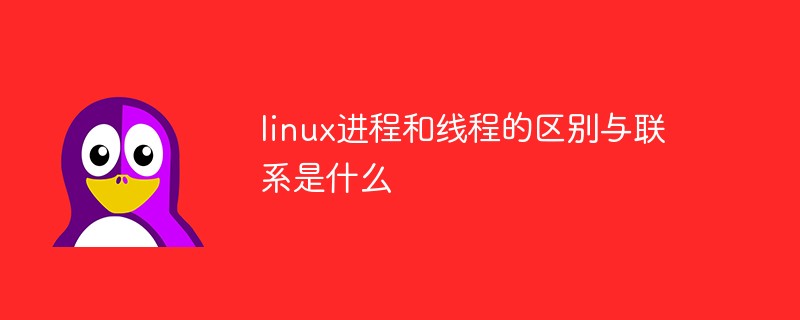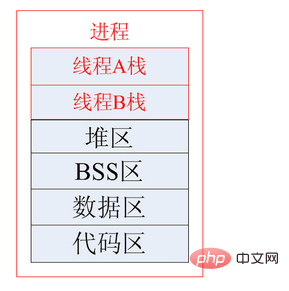 Operation and Maintenance
Operation and Maintenance
 Linux Operation and Maintenance
Linux Operation and Maintenance
 What is the difference and connection between linux processes and threads
What is the difference and connection between linux processes and threads
What is the difference and connection between linux processes and threads
Linux processes and threads: 1. The difference is that different operating system resource management methods, processes have independent address spaces, but there is no separate address space between threads; 2. The connection is that a thread can be created and canceled Another thread, multiple threads in the same process can execute concurrently, and threads are just different execution paths in a process.

#The operating environment of this tutorial: linux7.3 system, Dell G3 computer.
What is the difference and connection between Linux processes and threads
Contact:
One thread can create and cancel another Threads; multiple threads in the same process can execute concurrently.
Compared with processes, threads are a concept closer to execution bodies. They can share data with other threads in the same process. But it has its own stack space and an independent execution sequence.
Difference:
The main difference between processes and threads is that they are different operating system resource management methods. The process has an independent address space. After a process crashes, it will not affect other processes in protected mode, and threads are just different execution paths in a process. Threads have their own stacks and local variables, but there is no separate address space between threads. The death of one thread is equivalent to the death of the entire process. Therefore, multi-process programs are more robust than multi-thread programs, but when switching processes, it consumes a lot of time. The resources are larger and the efficiency is lower. However, for some concurrent operations that require simultaneous operation and sharing of certain variables, only threads, not processes, can be used.
In short, a program has at least one process, and a process has at least one thread.
The division scale of threads is smaller than that of processes. This enables high concurrency of multi-threaded programs.
In addition, the process has an independent memory unit during execution, and multiple threads share memory, thus greatly improving the running efficiency of the program.
Threads are still different from processes during execution. Each independent thread has an entry point for program execution, a sequential execution sequence, and an exit point for the program. However, threads cannot execute independently and must exist in the application program, and the application program provides multiple thread execution control.
From a logical point of view, the meaning of multi-threading is that in an application, multiple execution parts can be executed at the same time. However, the operating system does not regard multiple threads as multiple independent applications to implement process scheduling and management and resource allocation. This is the important difference between processes and threads.
Extended knowledge
In many classic operating system textbooks, the process is always defined as the execution of the program An instance does not perform anything, it just maintains various resources required by the application, while a thread is the real execution entity.
In order for a process to complete a certain amount of work, the process must contain at least one thread.

Process, intuitively speaking, after the program saved on the hard disk is run, an independent memory body will be formed in the memory space. This memory body has its own address space. , has its own heap, and the upper-level affiliated unit is the operating system.
Threads exist in processes and are the smallest units for scheduling and execution by the operating system. To put it simply, threads do work. \color{red}{Threads are what work. }Threads are what do the work.
A process is a program with certain independent functions. A running activity on a certain data set. A process is an independent unit for resource allocation and scheduling in the system. A thread is an entity of a process and the basic unit of CPU scheduling and dispatch. It is a basic unit that is smaller than a process and can run independently. The thread itself basically does not own system resources, only a few resources that are essential for running (such as a program counter, a set of registers and a stack), but it can share all the resources owned by the process with other threads belonging to the same process. .
If the process is a resource steward, responsible for requesting resources from the owner, then the thread is the hard worker. If the process is a resource steward, responsible for requesting resources from the owner, then the thread is the hard worker. A housekeeper must complete a job, which requires at least one coolie. That is to say, a process contains at least one thread and can also contain multiple threads. If coolies want to work, they need to rely on the housekeeper, so a thread must belong to a certain process. The process has its own address space, and threads use the address space of the process. In other words, threads have access to the resources in the process, such as heaps, stacks, static storage areas, etc.
The thread is a proletariat, but when the proletariat works, it must have its own labor tool. This labor tool is the stack. The thread has its own stack. This stack still uses the address space of the process, but this space is used Threads are marked as stacks. Each thread will have its own private stack, which cannot be accessed by other threads.
What the process maintains are the resources (static resources) contained in the program, such as: address space, open file handle set, file system status, signal processing handler, etc.;
Threads maintain Maintained run-related resources (dynamic resources), such as: running stack, scheduling-related control information, signal sets to be processed, etc.;
Threads and processes have their own advantages and disadvantages in use: Thread execution overhead Small, but not conducive to resource management and protection; and the process is just the opposite.
Recommended learning: Linux video tutorial
The above is the detailed content of What is the difference and connection between linux processes and threads. For more information, please follow other related articles on the PHP Chinese website!

Hot AI Tools

Undresser.AI Undress
AI-powered app for creating realistic nude photos

AI Clothes Remover
Online AI tool for removing clothes from photos.

Undress AI Tool
Undress images for free

Clothoff.io
AI clothes remover

Video Face Swap
Swap faces in any video effortlessly with our completely free AI face swap tool!

Hot Article

Hot Tools

Notepad++7.3.1
Easy-to-use and free code editor

SublimeText3 Chinese version
Chinese version, very easy to use

Zend Studio 13.0.1
Powerful PHP integrated development environment

Dreamweaver CS6
Visual web development tools

SublimeText3 Mac version
God-level code editing software (SublimeText3)

Hot Topics
 1386
1386
 52
52
 How to use docker desktop
Apr 15, 2025 am 11:45 AM
How to use docker desktop
Apr 15, 2025 am 11:45 AM
How to use Docker Desktop? Docker Desktop is a tool for running Docker containers on local machines. The steps to use include: 1. Install Docker Desktop; 2. Start Docker Desktop; 3. Create Docker image (using Dockerfile); 4. Build Docker image (using docker build); 5. Run Docker container (using docker run).
 Difference between centos and ubuntu
Apr 14, 2025 pm 09:09 PM
Difference between centos and ubuntu
Apr 14, 2025 pm 09:09 PM
The key differences between CentOS and Ubuntu are: origin (CentOS originates from Red Hat, for enterprises; Ubuntu originates from Debian, for individuals), package management (CentOS uses yum, focusing on stability; Ubuntu uses apt, for high update frequency), support cycle (CentOS provides 10 years of support, Ubuntu provides 5 years of LTS support), community support (CentOS focuses on stability, Ubuntu provides a wide range of tutorials and documents), uses (CentOS is biased towards servers, Ubuntu is suitable for servers and desktops), other differences include installation simplicity (CentOS is thin)
 What to do if the docker image fails
Apr 15, 2025 am 11:21 AM
What to do if the docker image fails
Apr 15, 2025 am 11:21 AM
Troubleshooting steps for failed Docker image build: Check Dockerfile syntax and dependency version. Check if the build context contains the required source code and dependencies. View the build log for error details. Use the --target option to build a hierarchical phase to identify failure points. Make sure to use the latest version of Docker engine. Build the image with --t [image-name]:debug mode to debug the problem. Check disk space and make sure it is sufficient. Disable SELinux to prevent interference with the build process. Ask community platforms for help, provide Dockerfiles and build log descriptions for more specific suggestions.
 How to view the docker process
Apr 15, 2025 am 11:48 AM
How to view the docker process
Apr 15, 2025 am 11:48 AM
Docker process viewing method: 1. Docker CLI command: docker ps; 2. Systemd CLI command: systemctl status docker; 3. Docker Compose CLI command: docker-compose ps; 4. Process Explorer (Windows); 5. /proc directory (Linux).
 Detailed explanation of docker principle
Apr 14, 2025 pm 11:57 PM
Detailed explanation of docker principle
Apr 14, 2025 pm 11:57 PM
Docker uses Linux kernel features to provide an efficient and isolated application running environment. Its working principle is as follows: 1. The mirror is used as a read-only template, which contains everything you need to run the application; 2. The Union File System (UnionFS) stacks multiple file systems, only storing the differences, saving space and speeding up; 3. The daemon manages the mirrors and containers, and the client uses them for interaction; 4. Namespaces and cgroups implement container isolation and resource limitations; 5. Multiple network modes support container interconnection. Only by understanding these core concepts can you better utilize Docker.
 What computer configuration is required for vscode
Apr 15, 2025 pm 09:48 PM
What computer configuration is required for vscode
Apr 15, 2025 pm 09:48 PM
VS Code system requirements: Operating system: Windows 10 and above, macOS 10.12 and above, Linux distribution processor: minimum 1.6 GHz, recommended 2.0 GHz and above memory: minimum 512 MB, recommended 4 GB and above storage space: minimum 250 MB, recommended 1 GB and above other requirements: stable network connection, Xorg/Wayland (Linux)
 How to switch Chinese mode with vscode
Apr 15, 2025 pm 11:39 PM
How to switch Chinese mode with vscode
Apr 15, 2025 pm 11:39 PM
VS Code To switch Chinese mode: Open the settings interface (Windows/Linux: Ctrl, macOS: Cmd,) Search for "Editor: Language" settings Select "Chinese" in the drop-down menu Save settings and restart VS Code
 What is vscode What is vscode for?
Apr 15, 2025 pm 06:45 PM
What is vscode What is vscode for?
Apr 15, 2025 pm 06:45 PM
VS Code is the full name Visual Studio Code, which is a free and open source cross-platform code editor and development environment developed by Microsoft. It supports a wide range of programming languages and provides syntax highlighting, code automatic completion, code snippets and smart prompts to improve development efficiency. Through a rich extension ecosystem, users can add extensions to specific needs and languages, such as debuggers, code formatting tools, and Git integrations. VS Code also includes an intuitive debugger that helps quickly find and resolve bugs in your code.



